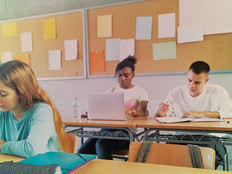1. Calm the Storm and Work Methodically
There are four stages in realizing that students are at a high level of risk in the era of remote learning. The first stage is awareness, which is followed by panic. This panic can take on different levels of severity, but it almost always leads to some level of paralysis and inactivity.
Allow yourself to feel this, and then work to the third level: acceptance. Accept that this is the new reality for students. Then, quickly — and calmly — protect students in the fourth stage, which is action. It’s crucial in this stage to make a plan but also stay flexible and patient as you travel through uncharted waters.
2. Create a Safe and Secure Digital Space
Start with a plan and have a clear idea of your goals. For example, determine whether you want students to have unrestricted access to social media or if you prefer a more structured approach. Also, decide to what extent you’ll monitor online activity and what digital resources students will be allowed to use. In the classroom, for instance, teachers can limit students to only those digital tools or resources that are relevant to the lesson at hand.
3. Communicate and Collaborate with Your Students
Once you have developed a clear vision for their digital lives, it’s important to communicate this to students directly. The nonprofit organization Common Sense Media offers visuals and videos that can scaffold this discussion.
As a teacher, there is a sense of scaffolding already in place, but the current situation still calls for finesse. Be honest with your concerns and educate students about the challenges of safely navigating the digital world. Also, make sure to listen to their ideas and goals so that you can work together to revise your plan as needed.
MORE FROM EDTECH: How to make the most of Chromebook security features.
4. Collect Information About the Digital Risks
It’s also important to take the time to learn more about the different threats students face online. Common Sense Media has many resources available that can help you stay up to date on those threats — from misinformation to cyberbullying. Additionally, the nonprofit organization Connect Safely offers research-based safety tips on numerous topics, such as social media, gaming and student privacy.
5. Connect with Organizations That Can Assist
There are plenty of organizations that are treasure troves of ideas and resources. One of the best ways to stay connected is to collaborate with local organizations and state agencies that conduct research and organize events to share and develop new ways to protect students online and spread awareness about digital safety and citizenship. Consider reaching out to other schools or professional learning communities to find more resources to use. There are also blogs that specifically discuss digital citizenship and internet safety to consider browsing, such as Common Sense Media’s Parenting, Media, and Everything In Between or PowerSchool’s Schoology Exchange, which explores technology issues of the day and occasionally touches on cybersafety.
6. Congratulate Yourself and Your Students for Success
One of the most powerful and potent strategies for protecting students from the dangers of cyberspace has nothing to do with computers at all. Most young people who are victims of cyberbullying have reported that they did not think anyone would listen to their concerns and that no one was on their side.
So, reach out to your students. Be on their side. Congratulate them, and yourself, for taking this first important step to securing their emotional and social well-being.











